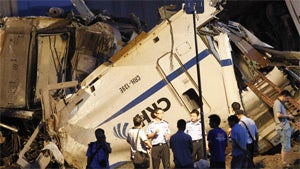Your support helps us to tell the story
From reproductive rights to climate change to Big Tech, The Independent is on the ground when the story is developing. Whether it's investigating the financials of Elon Musk's pro-Trump PAC or producing our latest documentary, 'The A Word', which shines a light on the American women fighting for reproductive rights, we know how important it is to parse out the facts from the messaging.
At such a critical moment in US history, we need reporters on the ground. Your donation allows us to keep sending journalists to speak to both sides of the story.
The Independent is trusted by Americans across the entire political spectrum. And unlike many other quality news outlets, we choose not to lock Americans out of our reporting and analysis with paywalls. We believe quality journalism should be available to everyone, paid for by those who can afford it.
Your support makes all the difference.A bullet train crashed into another high-speed train in eastern China, killing at least 35 people, injuring 191 others and once again raising safety concerns about the country's fast-expanding rail network.
The first train was traveling south from the Zhejiang provincial capital of Hangzhou yesterday evening when it lost power in a lightning strike and stalled, before being hit from behind by the second train in Wenzhou city, the official Xinhua News Agency said.
The first four carriages of the moving train fell about 65 to 100 feet (20 to 30 meters) off the viaduct onto the ground below. One carriage ended up in a vertical position, leaning against the viaduct.
The Ministry of Railways said in a statement on Sunday that the first four carriages of the moving train and the last two carriages of the stalled train derailed.
It was the first derailment on China's high-speed rail network since the country launched bullet trains with a top speed of 155 miles (250 kilometers) per hour in 2007, the China Daily reported.
It is an embarrassment for China, which plans to massively expand its bullet train network to link together its far-flung regions and show off its rising wealth and technological prowess. It is also trying to sell its trains to Latin America and the Middle East.
Last month, it launched to great fanfare the Beijing to Shanghai high-speed line, whose trains can travel at a top speed of 186 miles (300 kilometers) per hour. The speed was cut from the originally planned 217 mph (350 kph) after questions were raised about safety.
In less than four weeks of operation, power outages and other malfunctions have plagued the showcase 820-mile (1,318-kilometer) line. The Railways Ministry has apologized for the problems and said that summer thunderstorms and winds were the cause in some cases.
A total of 35 people died in Saturday's accident, including two foreigners, whose nationalities were unclear, said an official surnamed Wang in the Zhejiang provincial emergency office. A further 191 people were being treated at hospitals, said Wang, who gave only his surname, as is common with Chinese officials.
The second train had left Beijing and both trains were destined for Fuzhou in eastern Fujian province. Wang said it was unclear how long the first train had sat on the track before being struck.
Early Sunday, Chinese President Hu Jintao and Premier Wen Jiabao had called for an all-out effort to rescue passengers still trapped in the wreckage hours after the collision, Xinhua said. China Central Television later said the search-and-rescue operation had ended by 4 a.m. Sunday.
A preliminary investigation by the Zhejiang provincial government showed that four coaches of the moving train fell off the viaduct. The cars plunged about 65 to 100 feet (20 to 30 meters) from the elevated section of track, Xinhua said.
Xinhua quoted an unidentified witness as saying, "Rescuers have dragged many passengers out of the coach that fell on the ground."
The Wenzhou city government said more than 1,000 people participated in the rescue operation.
About 1,500 passengers were taken to a middle school, and more than 500 residents had given blood by 9 a.m. Sunday after appeals from the local blood bank, which said many of the injured needed transfusions, CCTV reported.
It was China's worst train accident since April 2008, when a train traveling from Beijing to the eastern coastal city of Qingdao derailed and crashed into another train, leaving 72 dead and another 416 injured.
Minister of Railways Sheng Guangzu, who rushed to the scene, ordered an in-depth investigation of Saturday's accident.
The trains involved are "D" trains — first-generation bullet trains.
China has spent billions of dollars and plans more massive investment to develop its high-speed rail network.
Official plans call for China's bullet train network to expand to 8,000 miles (13,000 kilometers) of track this year and 10,000 miles (16,000 kilometers) by 2020.
China's trains are based on Japanese, French and German technology but its manufacturers are trying to sell to Latin America and the Middle East. That has prompted complaints Beijing is violating the spirit of licenses with foreign providers by reselling technology that was meant to be used only in China.
The huge spending connected with the rail expansion also has been blamed for corruption. Railways Minister Liu Zhijun was dismissed this spring amid an investigation into unspecified corruption allegations.
No details have been released about the allegations against him, but news reports say they include kickbacks, bribes, illegal contracts and sexual liaisons.

Join our commenting forum
Join thought-provoking conversations, follow other Independent readers and see their replies
Comments